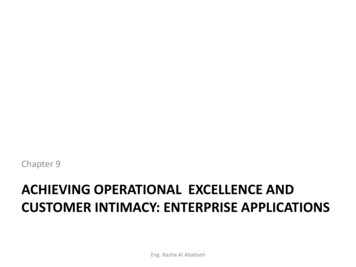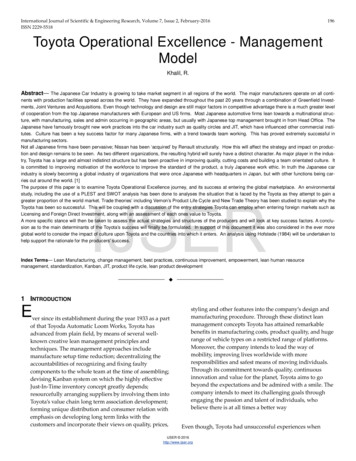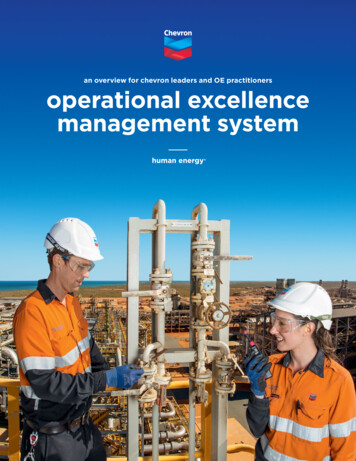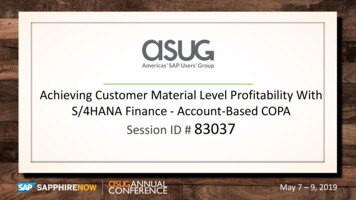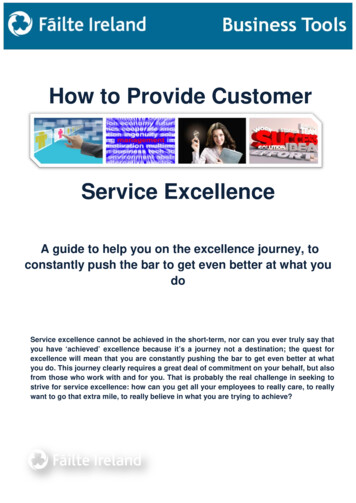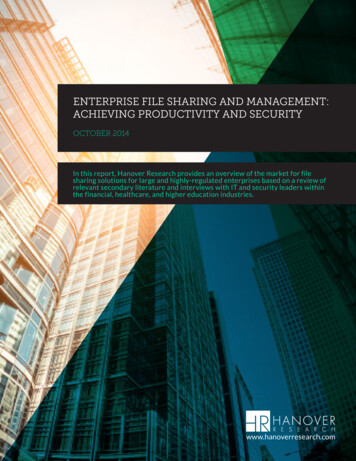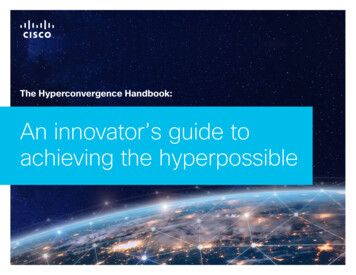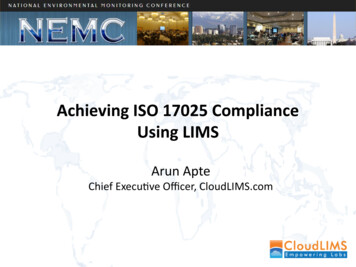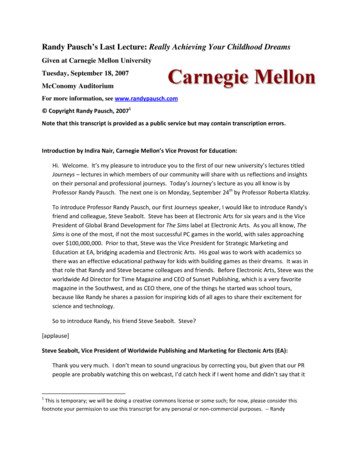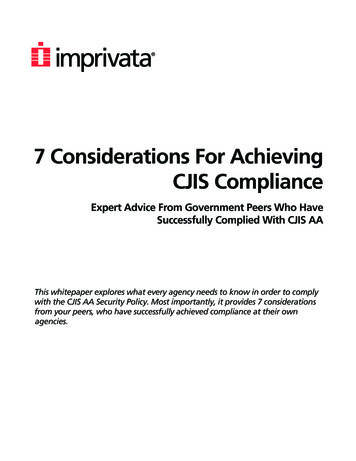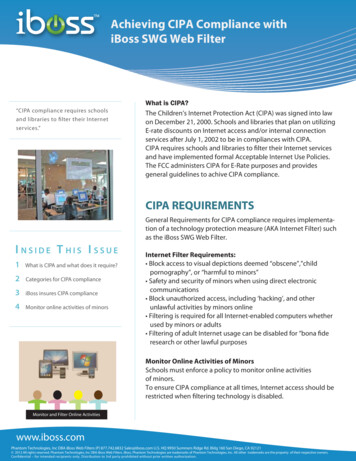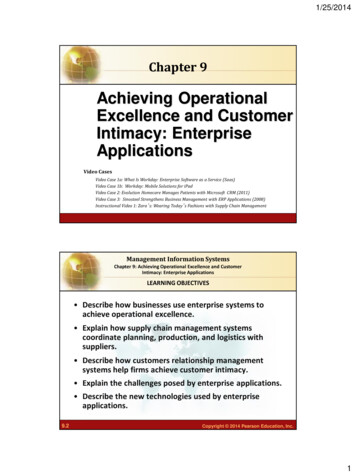
Transcription
1/25/2014Chapter 9Achieving OperationalExcellence and CustomerIntimacy: EnterpriseApplicationsVideo CasesVideo Case 1a: What Is Workday: Enterprise Software as a Service (Saas)Video Case 1b: Workday: Mobile Solutions for iPadVideo Case 2: Evolution Homecare Manages Patients with Microsoft CRM (2011)Video Case 3: Sinosteel Strengthens Business Management with ERP Applications (2008)Instructional Video 1: Zara’s: Wearing Today’s Fashions with Supply Chain Management6.1Copyright 2014 Pearson Education, Inc. publishing as Prentice HallManagement Information SystemsChapter 9: Achieving Operational Excellence and CustomerIntimacy: Enterprise ApplicationsLEARNING OBJECTIVES Describe how businesses use enterprise systems toachieve operational excellence. Explain how supply chain management systemscoordinate planning, production, and logistics withsuppliers. Describe how customers relationship managementsystems help firms achieve customer intimacy. Explain the challenges posed by enterprise applications. Describe the new technologies used by enterpriseapplications.9.2Copyright 2014 Pearson Education, Inc.1
1/25/2014Management Information SystemsChapter 9: Achieving Operational Excellence and CustomerIntimacy: Enterprise ApplicationsTechnology Helps Nvidia Anticipate the Future Problem: Volatile demand for chips, longproduction lead times, and manual planningprocesses Solution: System to forecast demand andreduce forecast planning time– SAP tools, including advanced planning andoptimization (APO) system Demonstrates use of technology to reducecosts, increase sales, and increase customersatisfaction9.3Copyright 2014 Pearson Education, Inc.Management Information SystemsChapter 9: Achieving Operational Excellence and CustomerIntimacy: Enterprise ApplicationsEnterprise Systems Enterprise Systems– Enterprise resource planning (ERP) systems– Suite of integrated software modules and acommon central database– Collects data from many divisions of firm for usein nearly all of firm’s internal business activities– Information entered in one process isimmediately available for other processes9.4Copyright 2014 Pearson Education, Inc.2
1/25/2014Management Information SystemsChapter 9: Achieving Operational Excellence and CustomerIntimacy: Enterprise ApplicationsEnterprise Systems Enterprise Software– Built around thousands of predefined business processesthat reflect best practices Finance and accounting Human resources Manufacturing and production Sales and marketing– To implement, firms: Select functions of system they wish to use. Map business processes to software processes.– Use software’s configuration tables for customizing.9.5Copyright 2014 Pearson Education, Inc.Management Information SystemsChapter 9: Achieving Operational Excellence and CustomerIntimacy: Enterprise ApplicationsHow Enterprise Systems WorkEnterprise systems feature a setof integrated software modulesand a central database thatenables data to be shared bymany different businessprocesses and functional areasthroughout the enterpriseFigure 9-19.6Copyright 2014 Pearson Education, Inc.3
1/25/2014Management Information SystemsChapter 9: Achieving Operational Excellence and CustomerIntimacy: Enterprise ApplicationsEnterprise Systems Business value of enterprise systems– Increase operational efficiency– Provide firm-wide information to support decisionmaking– Enable rapid responses to customer requests forinformation or products– Include analytical tools to evaluate overallorganizational performance9.7Copyright 2014 Pearson Education, Inc.Management Information SystemsChapter 9: Achieving Operational Excellence and CustomerIntimacy: Enterprise ApplicationsSupply Chain Management Systems Supply Chain– Network of organizations and processes for: Procuring materials, transforming them into products,and distributing the products– Upstream supply chain: Firm’s suppliers, suppliers’ suppliers, processes formanaging relationships with them– Downstream supply chain: Organizations and processes responsible for deliveringproducts to customers– Internal supply chain9.8Copyright 2014 Pearson Education, Inc.4
1/25/2014Management Information SystemsChapter 9: Achieving Operational Excellence and CustomerIntimacy: Enterprise ApplicationsNike’s Supply ChainFigure 9-2This figure illustrates the major entities in Nike’s supply chain and the flow of information upstream and downstreamto coordinate the activities involved in buying, making, and moving a product. Shown here is a simplified supply chain,with the upstream portion focusing only on the suppliers for sneakers and sneaker soles.9.9Copyright 2014 Pearson Education, Inc.Management Information SystemsChapter 9: Achieving Operational Excellence and CustomerIntimacy: Enterprise ApplicationsSupply Chain Management Systems Supply Chain Management– Inefficiencies cut into a company’s operating costs Can waste up to 25% of operating expenses– Just-in-time strategy: Components arrive as they are needed Finished goods shipped after leaving assembly line– Safety stock: Buffer for lack of flexibility in supply chain– Bullwhip effect Information about product demand gets distorted as itpasses from one entity to next across supply chain9.10Copyright 2014 Pearson Education, Inc.5
1/25/2014Management Information SystemsChapter 9: Achieving Operational Excellence and CustomerIntimacy: Enterprise ApplicationsThe Bullwhip EffectInaccurate information cancause minor fluctuations indemand for a product to beamplified as one moves furtherback in the supply chain. Minorfluctuations in retail sales for aproduct can create excessinventory for distributors,manufacturers, and suppliers.Figure 9.39.11Copyright 2014 Pearson Education, Inc.Management Information SystemsChapter 9: Achieving Operational Excellence and CustomerIntimacy: Enterprise ApplicationsSupply Chain Management Systems Supply Chain Management Software– Supply chain planning systems Model existing supply chain Enable demand planning Optimize sourcing, manufacturing plans Establish inventory levels Identify transportation modes– Supply chain execution systems Manage flow of products through distribution centersand warehouses9.12Copyright 2014 Pearson Education, Inc.6
1/25/2014Management Information SystemsChapter 9: Achieving Operational Excellence and CustomerIntimacy: Enterprise ApplicationsInteractive Session: ManagementLand O’Lakes Butter Becomes Fresher with Demand PlanningRead the Interactive Session and discuss the following questions Why are inventory management and demand planning so important forLand O’Lakes? What is the business impact of not being able to manageinventory or predict demand for this company? What management, organization, and technology issues had to beconsidered when selecting Oracle’s Demantra as a solution for LandO’Lakes? How did implementing Demantra change management decision makingand the way that Land O’Lakes ran its business? Describe two decisions that were improved by implementing Demantra.9.13Copyright 2014 Pearson Education, Inc.Management Information SystemsChapter 9: Achieving Operational Excellence and CustomerIntimacy: Enterprise ApplicationsSupply Chain Management Systems Global supply chain issues– Greater geographical distances– Greater time differences– Participants from different countries Different performance standards Different legal requirements Internet helps manage global complexities––––9.14Warehouse managementTransportation managementLogisticsOutsourcingCopyright 2014 Pearson Education, Inc.7
1/25/2014Management Information SystemsChapter 9: Achieving Operational Excellence and CustomerIntimacy: Enterprise ApplicationsSupply Chain Management Systems Supply chain management– Push-based model (build-to-stock) Earlier SCM systems Schedules based on best guesses of demand– Pull-based model (demand-driven) Web-based Customer orders trigger events in supply chain– Internet enables move from sequential supply chainsto concurrent supply chains Complex networks of suppliers can adjust immediately9.15Copyright 2014 Pearson Education, Inc.Management Information SystemsChapter 9: Achieving Operational Excellence and CustomerIntimacy: Enterprise ApplicationsPush- Versus Pull-Based Supply Chain ModelsFigure 9-49.16The difference between push- and pull-based models is summarized by the slogan “Make what we sell, not sellwhat we make.”Copyright 2014 Pearson Education, Inc.8
1/25/2014Management Information SystemsChapter 9: Achieving Operational Excellence and CustomerIntimacy: Enterprise ApplicationsThe Future Internet-Driven Supply ChainThe future Internet-driven supply chain operates like adigital logistics nervous system. It providesmultidirectional communication among firms, networksof firms, and e-marketplaces so that entire networks ofsupply chain partners can immediately adjust inventories,orders, and capacities.Figure 9-59.17Copyright 2014 Pearson Education, Inc.Management Information SystemsChapter 9: Achieving Operational Excellence and CustomerIntimacy: Enterprise ApplicationsSupply Chain Management Systems Business value of SCM systems–––––Match supply to demand; reduce inventory levelsImprove delivery serviceSpeed product time to marketUse assets more effectivelyReduced supply chain costs lead to increasedprofitability Total supply chain costs can be 75% of operatingbudget– Increase sales9.18Copyright 2014 Pearson Education, Inc.9
1/25/2014Management Information SystemsChapter 9: Achieving Operational Excellence and CustomerIntimacy: Enterprise ApplicationsCustomer Relationship Management Systems Customer relationship management (CRM)– Knowing the customer– In large businesses, too many customers and too manyways customers interact with firm CRM systems:– Capture and integrate customer data from all over theorganization– Consolidate and analyze customer data– Distribute customer information to various systems andcustomer touch points across enterprise– Provide single enterprise view of customers9.19Copyright 2014 Pearson Education, Inc.Management Information SystemsChapter 9: Achieving Operational Excellence and CustomerIntimacy: Enterprise ApplicationsCustomer Relationship Management (CRM)CRM systems examinecustomers from a multifacetedperspective. These systems usea set of integrated applicationsto address all aspects of thecustomer relationship,including customer service,sales, and marketing.Figure 9-69.20Copyright 2014 Pearson Education, Inc.10
1/25/2014Management Information SystemsChapter 9: Achieving Operational Excellence and CustomerIntimacy: Enterprise ApplicationsCustomer Relationship Management Systems CRM Software– Packages range from niche tools to large-scaleenterprise applications.– More comprehensive have modules for: Partner relationship management (PRM)– Integrating lead generation, pricing, promotions, orderconfigurations, and availability– Tools to assess partners’ performances Employee relationship management (ERM)– Setting objectives, employee performance management,performance-based compensation, employee training9.21Copyright 2014 Pearson Education, Inc.Management Information SystemsChapter 9: Achieving Operational Excellence and CustomerIntimacy: Enterprise ApplicationsCustomer Relationship Management Systems CRM software (cont.)– CRM packages typically include tools for: Sales force automation (SFA)– Sales prospect and contact information, sales quotegeneration capabilities Customer service– Assigning and managing customer service requests, Webbased self-service capabilities Marketing– Capturing prospect and customer data, scheduling andtracking direct-marketing mailings or e-mail, cross-selling9.22Copyright 2014 Pearson Education, Inc.11
1/25/2014Management Information SystemsChapter 9: Achieving Operational Excellence and CustomerIntimacy: Enterprise ApplicationsHow CRM Systems Support MarketingCustomer relationshipmanagement software providesa single point for users tomanage and evaluate marketingcampaigns across multiplechannels, including e-mail,direct mail, telephone, theWeb, and wireless messages.Figure 9-79.23Copyright 2014 Pearson Education, Inc.Management Information SystemsChapter 9: Achieving Operational Excellence and CustomerIntimacy: Enterprise ApplicationsCRM Software CapabilitiesThe major CRM softwareproducts support businessprocesses in sales, service, andmarketing, integratingcustomer information frommany different sources.Included are support for boththe operational and analyticalaspects of CRM.Figure 9-89.24Copyright 2014 Pearson Education, Inc.12
1/25/2014Management Information SystemsChapter 9: Achieving Operational Excellence and CustomerIntimacy: Enterprise ApplicationsCustomer Loyalty Management Process MapFigure 8-9This process map shows how a best practice for promoting customer loyalty through customer service wouldbe modeled by customer relationship management software. The CRM software helps firms identify high-valuecustomers for preferential treatment.9.25Copyright 2014 Pearson Education, Inc.Management Information SystemsChapter 9: Achieving Operational Excellence and CustomerIntimacy: Enterprise ApplicationsCustomer Relationship Management Systems Operational CRM:– Customer-facing applications such as sales forceautomation, call center and customer servicesupport, and marketing automation Analytical CRM:– Based on data warehouses populated by operationalCRM systems and customer touch points– Analyzes customer data (OLAP, data mining, etc.) Customer lifetime value (CLTV)9.26Copyright 2014 Pearson Education, Inc.13
1/25/2014Management Information SystemsChapter 9: Achieving Operational Excellence and CustomerIntimacy: Enterprise ApplicationsAnalytical CRM Data WarehouseAnalytical CRM uses acustomer data warehouse andtools to analyze customer datacollected from the firm’scustomer touch points and fromother sources.Figure 9-109
Chapter 9: Achieving Operational Excellence and Customer Intimacy: Enterprise Applications CRM software (cont.) –CRM packages typically include tools for: Sales force automation (SFA) –Sales prospect and contact information, sales quote generation capabilities Customer service –Assigning and managing customer service requests, Web-
